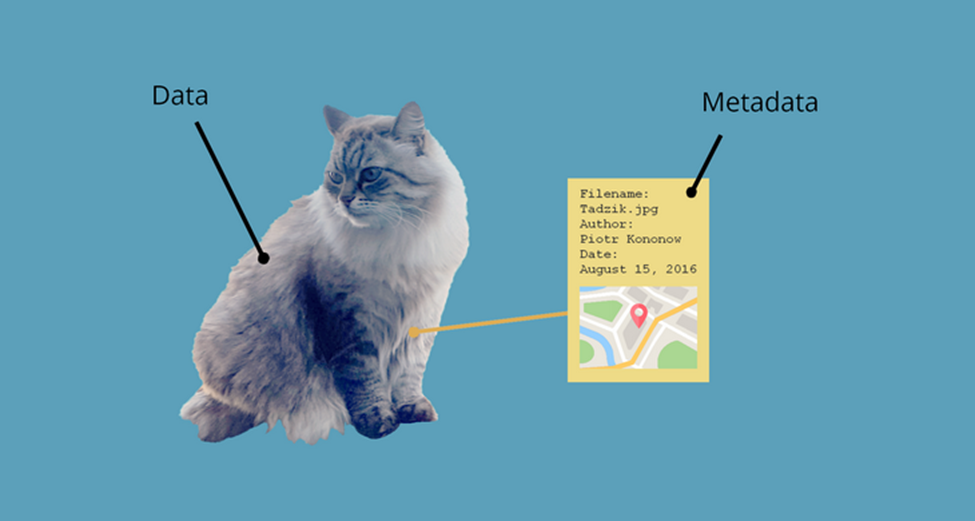Time To Get Meta: Uncovering the Truth About Metadata
I recently I dug into the magical power of going beyond words and phrases using sentiment analysis in electronic discovery. But did you know that Metadata is the secret weapon in deciphering content and context? You see, every document or email you send has a whole host of data about the data on the page. It's generated by the data source, beyond the face of the document or electronically stored information (ESI).
The universe of data about data can highlight the smoking gun... or tell a tale far different from the face value of a document.
Buckle up because this ride's about to get meta... very meta.

So, What Is Metadata Anyway?
Picture this: you're cozy, chilling with your laptop, sipping on your third cup of caffeine for the day. Suddenly, a wild file named "VeryBoring.docx" appears. You shrug, about to dismiss it, but wait! What's this in its metadata? The name, the date, the author, even some saucy track changes. And just like that, "VeryBoringData.docx" doesn't seem so boring anymore.
So, what gives? The answer, my friends, lies in the mysterious underbelly of every file: the world of metadata. This 'data about data' may seem like a geeky Pandora's box, but believe me, it's a digital detective's best friend. Through this blog, we're going to crack open that box, demystifying the role of metadata in eDiscovery and tech compliance.
In this post, we'll take a magnifying glass to metadata, breaking it down byte by byte. This is your backstage pass to the great meta party, and trust me, it's a bash you don't want to miss. Buckle up, tech fam - it's time to get meta!

The Metadata Mixtape: Types of Metadata
Metadata is data embedded in the various information systems humans use to create ESI. Everything from search engines to spreadsheets has many data points that savvy discovery detectives can use to understand the who, what, when, and where of their data set and their case.
But what examples of metadata can digital forensics experts or legal case teams dive into?
Let's get this party popping by spinning the turntables on the different types of metadata. That's right, metadata isn't just a one-hit wonder; it's an eclectic mixtape with its own set of catchy beats rife with electronic evidence.
Application Metadata:
This is the track that gets the party started. Its metadata created by the software you used to create your document. So, whether you're jamming on Word or dancing with Photoshop, application metadata records the history of your groove. It can tell us things like who played the track (created the document). Or, when they hit the play button (date and time of creation), and even if the tune has been remixed (revisions or modifications).
It's like the digital footprints left behind at a crime scene, providing a tale of the document's digital journey. Buckle up, as we dive into a few examples of these hidden gems:
- Creator: Just like a whodunit mystery, every document has a creator. Your application tags the file with the name of the person (or rather, their user account) who first breathed life into it. It's akin to an artist signing their masterpiece!
- Creation Date: Imagine having a time machine that lets you pinpoint exactly when the create date of file came into existence. Well, guess what? Application metadata does just that. It's like your file's birth certificate!
- Modification Dates and Authors: This one's for the curious cats out there, always wanting to know who tinkered with a file and when. This metadata is the breadcrumb trail of the edits made to a document, keeping track of every change and the user who made it.
- Document Version: Ever wondered how many iterations your file went through before reaching its final form? Just like a book goes through drafts, so does your document, and the application metadata faithfully keeps count.
- Software Version: This one's a shoutout to the software that facilitated your document's creation. Whether you crafted it on Word 2016 or drafted it on Photoshop CC 2023, this metadata has got it recorded.
- Word Count/Duration/Resolution: Depending on the type of file, this could be the word count for a document, the duration for an audio/video file, or the resolution for an image. It's like the vital stats of your file!

File System Metadata:
This is like the club bouncer of your data party. System metadata doesn't care about the electronic document's contents, but it keeps an eye on its moves on the dance floor (your system). It notes when the file enters the club (create date), the times it boogies (accessed), and the last dance (modified). So, if you're ever wondering when that "Taxes2023.docx" last cut a rug, look no further than the system-generated document metadata.
It's like the cryptic postmarks on a secret letter, giving away details without making a sound. Let's pull back the curtain on a few examples of these covert electronic data operators:
- File Type: This is like the ID badge of your electronic file, proclaiming whether it's a word document, an image, an excel spreadsheet, or a video file. It's the backstage pass into understanding the nature of your file.
- File Size: A measure of how much digital space your file takes up. Just like you'd measure the size of your new trendy sneakers, your system keeps tabs on the size of your file.
- File Path: Ever felt like Hansel and Gretel, wanting to trace back your steps in the vast forest of your hard drive? Fear not, because your file path is your very own breadcrumb trail, leading you back to the origin of your file.
- Operating System: Just like we remember the locations of our epic adventures, the metadata records the operating system where your file had its grand journey. It's like the travel log for your file, capturing its journey in the realm of operating systems.
- Dates Accessed: This is the secret logbook, recording the dates when your file was accessed. Like a dutiful librarian, it keeps track of every visit your file gets.
- Permissions: The unsung heroes that guard the gates of your files, setting the rules about who can view, modify, or share your files. They're like the bouncers at the club, controlling who gets past the velvet rope.

User Metadata:
Now, this is where the meta-dance floor gets interactive. User metadata is the metadata you add to the beat. It's the shout-outs, the comments, the "OMG, this track is lit" remarks. This could be your tags, ratings, or even that spicy comment in the margins of a shared Google Doc. User metadata is your footprint on the data dance floor.
The final piece of our metadata puzzle. It's the graffiti on the digital wall, the personal touch, or the sticky note attached to your files, adding another layer of information. Let's check out some examples:
- Bookmarks: Oh, the humble bookmarks! Your very own digital Hansel-and-Gretel breadcrumb trail, marking the memorable electronic document or web URL in your digital journey. These little markers are a user's way of saying, "this part is important."
- Tags and Labels: It's like the nametag at a networking event, a shout-out to categorize or highlight files. From the classic 'Important' to the 'Don't-Forget', these tags and labels offer insights into a user's mind.
- Ratings and Likes: An overt nod of approval or disapproval. Your file may not be on social media, but you can still give it a thumbs up or a star rating. These are the digital cheers or boos for your files.
- Comments: Here's where we put our digital quills to work. Annotations, notes, thoughts, or those brilliant midnight eureka moments – they all find a home in the comments section of the metadata.
- User-based permissions: Who's invited to the party and who's left off the guest list? These are the controls that decide who gets to view, modify, or collaborate on a file.

Getting Meta with Email and Text Messages
When it comes to Discovery two of the biggest metadata sources that legal teams find relevant are email and Text messages.
Text Message Metadata:
Text messages come with a variety of metadata. Some examples include:
- Sender and Receiver Information: This includes the phone numbers of both the sender and the receiver.
- Date and Time: The date and time the message was sent and possibly when it was received or opened.
- Message Status: Details such as whether the message was sent, delivered, read, or if there was a delivery failure.
- Device Information: Information about the device from which the message was sent. This could include the device model, the operating system, or even the software version of the messaging app.
- Location Data: If location services are enabled, some messages might have geographic metadata attached.
- Length of Message: Some metadata might include the length of the message in characters.
- Message Identifier: A unique identifier for each message.
- Group Message Details: In the case of group messages, metadata could also include information about the group, like the name of the group chat, and who are its participants.
Remember that the exact metadata attached to a text message can vary depending on the messaging service used (SMS, iMessage, WhatsApp, etc.), the devices involved, and the privacy settings in place.

Email Metadata:
Emails also come with a wealth of metadata. Some examples include:
- From, To, CC, BCC: These fields identify who sent the email, who the intended recipients are, and who else received copies.
- Subject Line: This is the topic of the email as entered by the sender.
- Date and Time: The date and time when the email was sent and received.
- Message-ID: A unique identifier generated by the mail system for each message.
- In-Reply-To and References: These fields are used in replies and forwards to link emails together in a conversation.
- Email Size: The total size of the email, including attachments.
- Attachments: Information about any files attached to the email, including file name, file type, and file size.
- Content Type: This identifies the format of the email, such as plain text or HTML.
- Read Receipt Request: Whether or not the sender requested a read receipt.
- IP Addresses: The IP addresses associated with the email's path across the internet, found in the email header.
- Server and Client Information: This could include the email client used to compose the email, the servers it passed through, and more.
- Mail User Agent: The software tool used to send the email, like Outlook or Gmail web interface.
Remember, as with text messages, the specific metadata attached to an email can vary depending on the email service, the devices involved, and the settings in place. Also, keep in mind that privacy laws can dictate what email metadata can be legally collected and how it can be used.

But Wait There’s More
There are many additional metadata fields beyond the ones mentioned in our conversation. The specific fields can vary widely depending on the file type, the system or application creating the metadata, and how users interact with the files. Here are some examples:
- Geolocation data: For certain file types, especially those created on mobile devices, metadata can include the GPS coordinates where the file was created or modified.
- EXIF data: This is specific to images and provides a wide range of information including camera model, exposure setting, date, and time the photo was taken, and more.
- Embedded Metadata: This type of metadata is stored inside the file itself and travels with the file. For example, a Word document contains embedded metadata such as the author, date created, and date modified.
- Document Properties: This can include things like word count, page count, language, format, and other details related to the document itself.
- File System Data: Data related to how the file is stored on your computer, such as file path, creation date, modification date, access permissions, and more.
- Version History: For certain applications, metadata can include a history of changes made to the document, who made them, and when.
And just like that, you're grooving to the beat of metadata. Remember, just as every partygoer adds their unique move to the mix, every file brings its unique metadata beat to the dance floor. So, the next time you boogie with your data, don't forget to appreciate its metadata mixtape. Now, that's what I call a meta-move!


